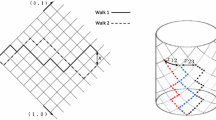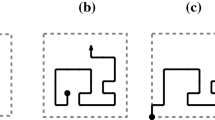Abstract.
Using the complementary approaches of Flory theory and the overlap function, we study the molecular weight distribution and conformation of hyperbranched polymers formed by the melt polycondensation of A-R N 0-Bf - 1 monomers in their reaction bath close to the mean field gel point p A = 1, where p A is the fraction of reacted A groups. Here \(f\geq 3\), N 0 is the degree of polymerisation of the linear spacer linking the A group and the f-1 B groups and condensation occurs exclusively between the A and B groups. For \(\varepsilon \equiv \left(1-p_{A}\right) \ll1\), we assume that the number density of hyperbranched polymers with degree of polymerisation N generally obeys the scaling form \(n\left(N\right) = N^{-\tau}f\left(N/N_{l}\right) \) and we explicitly show that this scaling assumption is correct in the mean field regime (here N l is the largest characteristic degree of polymerisation and the function \(f\left(N/N_{l}\right) \) cuts off the power law sharply for \(N>N_{l}\)). We find the upper critical dimension for this system is d c = 4, so that for \(d\geq d_{c}\) the mean field values for the polydispersity exponent and fractal dimension apply: \(\tau = 3/2\), d f = 4. For d = 3, mean field theory is still correct for \( \varepsilon >\varepsilon_{G}\) where \(\varepsilon_{G}\cong N_{0}^{-1}\) is the Ginzburg point; for \(\varepsilon <\varepsilon_{G}\), mean field theory applies on small mass scales N<N c but breaks down on larger mass scales N>N c where \(N_{c}\cong N_{0}^{3}\) is a cross-over mass. Within the Ginzburg zone (i.e., d<d c , \(\varepsilon <\varepsilon_{G}\)), we show that the hyperbranched chains on mass scales N>N c are non-Gaussian with fractal dimension given by d f = d (for d = 2,3,4). Our results are qualitatively different from those of the percolation model and indicate that the polycondensation of AB f-1, unlike polymer gelation, is not described by percolation theory. Instead many of our results are similar to those for a monodisperse melt of randomly branched polymers, a consequence of the fact that \(\tau <2\) so that polydispersity is irrelevant for excluded volume screening in hyperbranched polymer melts.
Similar content being viewed by others
References
P.J. Flory, J. Am. Chem. Soc. 74, 2718 (1952)
P.J. Flory, Principles of Polymer Chemistry (Cornell University Press, Ithaca, 1953)
L.J. Hobson, W.J. Feast, Chem. Commun. 21, 2067 (1997)
D.J. Read, T.C.B. McLeish, Macromolecules 34, 1928 (2001)
D. Stauffer, A. Aharony, Introduction to Percolation Theory,2nd edn. (Taylor & Francis, London, 1994)
T.C. Lubensky, J. Isaacson, S.P. Obukhov, J. Phys. France 42, 1591 (1981)
C. Cameron, A.H. Fawcett, C.R. Hetherington, R.A.W. Mee, F.V. McBride, J. Chem. Phys. 108, 8235 (1998)
C. Cameron, A.H. Fawcett, C.R. Hetherington, R.A.W. Mee, F.V. McBride, Macromolecules 33, 6551 (2000)
Suneel et al., Macromolecules 35, 9605 (2002)
S. Kunamaneni, D.M.A. Buzza, D. Parker, W.J. Feast, J. Mater. Chem. 13, 2749 (2003)
B.H. Zimm, W.H. Stockmayer, J. Chem. Phys. 17, 1301 (1949)
T.C. Lubensky, J. Isaacson, Phys. Rev. A 20, 2130 (1979)
P.G. de Gennes, Scaling Concepts in Polymer Physics (Cornell University Press, Ithaca, 1979)
P.G. de Gennes, Comptes Rend. Acad. Sci. Paris 291, 17 (1980)
P.G. de Gennes, J. Phys. Lett. France 38, L355 (1977)
M. Daoud, E. Bouchaud, G. Jannink, Macromolecules 19, 1955 (1986)
M. Rubinstein, R.H. Colby, Polymer Physics (Oxford University Press, Oxford, 2003)
S.F. Edwards, Proc. Phys. Soc. London 88, 265 (1966)
J. Isaacson, T.C. Lubensky, J. Phys. Lett. France 41, L469 (1980)
M.E. Cates, J. Phys. Lett. France 46, L837 (1985)
P. Flory, J. Chem. Phys. 17, 303 (1949)
See reference [13] pp. 59-60
This form for R(N) is valid in the mean field regime which is the subject of this section. In the non-mean field regime however, the form for R(N) is more complex because there are two fractal dimensions on mass scales N>N 0, see Section 4.
M. Daoud, J.F. Joanny, J. Phys. France 42, 1359 (1981)
The result d fg =4 is exact for \(d\ge 4\). For d< 4, the screened fractal dimension is given by the more general result d fg =2d s /(2−d s ) [27] where d s is the spectral dimension characterising the intrinsic connectivity of the branched polymer. For d< 4, because of the presence of intramolecular loops, d s may be slightly different from the mean field value of d s =4/3 for loopless trees
M. Cates, Ph.D. thesis, Cambridge University, England, 1985
M.E. Cates, J. Phys. France 46, 1059 (1985)
S. Kunamaneni, D. Buzza, E. de Luca, R.W. Richards, to be published
Author information
Authors and Affiliations
Corresponding author
Additional information
Received: 15 December 2003, Published online: 2 March 2004
PACS:
82.35.-x Polymers: properties; reactions; polymerization - 05.70.Jk Critical point phenomena
Rights and permissions
About this article
Cite this article
Buzza, D.M.A. Power law polydispersity and fractal structure of hyperbranched polymers. Eur. Phys. J. E 13, 79–86 (2004). https://doi.org/10.1140/epje/e2004-00042-3
Issue Date:
DOI: https://doi.org/10.1140/epje/e2004-00042-3




